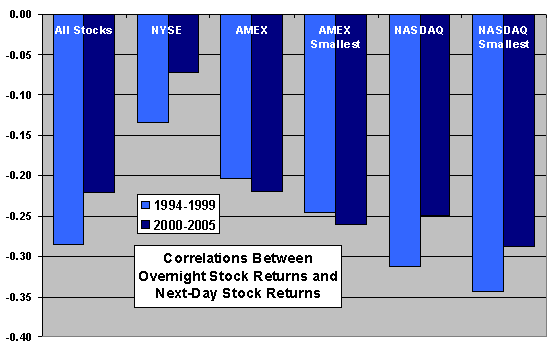Does an opening stock price above or below the prior session close indicate price movement for the rest of the trading day? If so, is the indication tradable. In their September 2006 paper entitled “The Overnight Return: One More Anomaly”, Ben Branch and Aixin Ma investigate the relationships between overnight and adjacent intraday returns for individual stocks. Using NYSE, AMEX and NASDAQ data over the period 1994-2005, they find that:
- The overnight return exhibits a significant negative correlation (-0.22 over the entire sample) with the following daily return. There are also significant correlations between the overnight return and the prior daily return (-0.12) and between the overnight return and the prior overnight return (+0.06).
- These relationships are generally stronger for small capitalization stocks. Strongest indications are for small AMEX and NASDAQ stocks.
- Results hold across exchanges and for both the 1994-1999 and 2000-2005 subperiods.
- Because of trading costs (bid-ask spreads and transaction fees), it is unclear whether traders other than specialists/market makers can exploit these tendencies.
The following chart, constructed from data in the paper, shows the correlations between overnight and next-day individual stock returns for various subsamples. It shows a consistent tendency for stock prices to reverse the overnight return. It also shows that this tendency is stronger for AMEX and NASDAQ stocks and for small stocks (smallest here means the smallest one-fifth based on market capitalization).

The authors note that specialists/market makers have the following incentives for moving the daily opening price away from the prior daily close: (1) trigging limit orders, thereby generating fees; (2) providing liquidity (other than the specialist/market maker inventory) for new market orders; and, (3) generating trading activity.
In summary, the overnight return on individual stocks is a contrary indicator for next-day returns, but individual “outside” traders may not be able to exploit this tendency.
In a related September 2006 paper entitled “Closed End Fund Performance on a Daily Basis: The Discovery of a New Anomaly”, Ben Branch, Aixin Ma and Jill Sawyer examine an aggregated version of this same tendency for closed end funds.